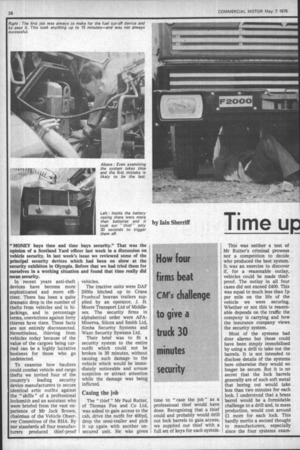Time up for thieving
Page 28

Page 29

If you've noticed an error in this article please click here to report it so we can fix it.
This was neither a test of Mr Rutter's criminal prowess nor a competition to decide who produced the best system. It was an exercise to discover if, for a reasonable outlay, vehicles could be made thiefproof. The outlay in all four cases did not exceed £400. This was equal to much less than lp per mile on the life of the vehicle we were securing. Whether or not this is reasonable depends on the traffic the company is carrying and how the insurance company views the security system.
Most of the systems had door alarms but these could have been simply immobilised by using a drill to take out the barrels. It is not intended to disclose details of the systems here otherwise they would no longer be secure. But it is no secret that the lock barrels generally are of such soft metal that boring out would take less than two minutes for each lock. I understand that a brass barrel would be a formidable challenge to a drill and, in mass production, would cost around El more for each lock. This hardly merits a second thought to manufacturers, especially since the four systems exam ined were otherwise impregnable.
The Elva
The first vehicle that Mr Rutter tackled was fitted with a Silcox and Smith Elva system. It cost £370 and as described in CM last week it was fully automated.
Our man went immediately under the vehicle to disconnet the fuel cut-off device. He managed to do this successfully but later discovered that, while he had by-passed one device, another less obvious one was in operation. It took 20 minutes to complete this task and the time was totally wasted. This applied to all of the other vehicles which were fitted with one form of cut-off device or another.
Time up
After immobilising the Elva alarms, he entered the cab without difficulty and without damage. But half an hour had gone before our thief was seated behind the wheel and even then he was still fooled.
The Elva code system which immobilises the vehicles at a flick of a switch in the cab could not be broken. With the hand-brake apparently off the brakes were still hard on and with the ignition switched on the engine only coughed momentarily and belched a cloud of smoke through the exhaust. Without the code the vehicle could not be started and after 45 minutes, vehicle and cargo were still safe.
Simba sounds off
The Simba was the exception to the time rule. It seemed that Mr Rutter had only looked at it when the alarm went off. As he leant over the battery casing to look at the fuel system, he touched a part of the chassis which triggered off the klaxon and the subsequent noise would certainly have been sufficient to have sent even the most desperate of thieves off at a fast gallop. This happened after 30 seconds.
To follow the system through, the alarm was switched off. But, at every point, Mr Rutter triggered off a new alarm. The system proved highly effective and even armed with keys, he took 40 minutes to get into the cab with the assistance of a colleague. He was still unable to get the vehicle moving despite having by-passed the cut-off. So, for an expenditure of about £400 the vehicle and its load were saved.
Waso's way
By the time he reached the third vehicle Mr Rutter was familiar with most of the builtin tricks in the systems. He and his colleague were by then working as a team thus reducing the time on the job but it did not help to break through the Waso system.
In the fastest time yet he disconnected the fuel cut-off while his colleague took the klaxon apart, but it still took them 25 minutes working full out to get into the cab.
Immediately he switched on, another klaxon blew; there was no way that he could go undetected, the systems were switched off and cleared and Paul started again. Inside five minutes and before the vehicle moved—off went the klaxon once more. Although he managed on this occasion to get the engine running the vehicle did no more than jump like a kangaroo and so after 35 minutes he Ind to admit defeat. The Waso system cost in the region of £350.
Fever pitch
The fourth system was fitted by AFA-Minerva. Once more Paul went for the fuel cut-off then shorted out the batteries and the ignition switch. Working at what appeared to be fever pitch he severed switches, cut cables, broke the alarm and disconnected the steering lock, but could not find his way round AFA's immobiliser. His pace was undoubtedly faster here than on any other system and even armed with keys it took 45 minutes to get into the cab only to find once more that he could not move the vehicle. The AFA system was also priced at around £350.
For very obvious reasons the systems haven't been described here in detail. Sufficient to say that they all proved highly successful, they all bought precious time.
The cost factor is, of course, of paramount importance. The cost per mile is so small that it can hardly be calculated. Assuming a vehicle life of 400,000 miles and a security cost of £400, the cost per mile is 0.0001 of 1 p.




























































































